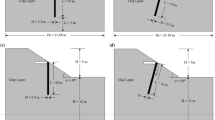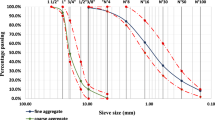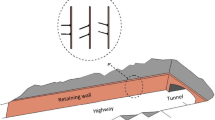Abstract
Rice husk ash (RHA) is a commonly found pozzolanic material that has been used as a partial substitute for cement to reduce greenhouse gas emissions. Concrete-rice husk ash (C-RHA) piles can become an eco-friendly and cost-efficient slope reinforcement alternative. Therefore, a series of centrifuge modeling tests were conducted to understand the stabilities of precast and cast-on-site C-RHA pile-reinforced slopes when subjected to gravity loading. The results show that the precast construction method more substantially improves the slope stability immediately after construction because the precast pile strength peaks before the cast-on-site concrete is fully cured. Moreover, the cast-on-site C-RHA pile-reinforced slope is much more stable after the mixture is fully cured because the grout material creates better bonding between the pile and the surrounding soil as it seeps into the surrounding soil, improving the slope strength and stability.
















Similar content being viewed by others
Data Availability
All data, models, and code generated or used during the study appear in the submitted article will be made available upon reasonable request.
References
ASTM Standard D2166/D2166M-16 (2016) Standard test method for unconfined compressive strength of cohesive soil. ASTM International, West Conshohocken, PA. https://doi.org/10.1520/D2166_D2166M-16
Chen S-C, Wu C-H (2006) Slope stabilization and landslide size on Mt. 99 peaks after chichi earthquake in Taiwan. Environ Geol 50(5):623–636. https://doi.org/10.1007/s00254-006-0236-y
Fan C-C, Luo J-H (2008) Numerical study on the optimum layout of soil–nailed slopes. Comput Geotech 35(4):585–599. https://doi.org/10.1016/j.compgeo.2007.09.002
He J, Jie Y, Zhang J, Yu Y, Zhang G (2013) Synthesis and characterization of red mud and rice husk ash-based geopolymer composites. Cement Concr Compos 37:108–118. https://doi.org/10.1016/j.cemconcomp.2012.11.010
He Z, Li L, Du S (2017) Creep analysis of concrete containing rice husk ash. Cement Concr Compos 80:190–199. https://doi.org/10.1016/j.cemconcomp.2017.03.014
Jamil M, Kaish ABMA, Raman SN, Zain MFM (2013) Pozzolanic contribution of rice husk ash in cementitious system. Constr Build Mater 47:588–593. https://doi.org/10.1016/j.conbuildmat.2013.05.088
Kim Y, Lee S, Jeong S, Kim J (2013) The effect of pressure-grouted soil nails on the stability of weathered soil slopes. Comput Geotech 49:253–263. https://doi.org/10.1016/j.compgeo.2012.12.003
Lin H, Xiong W, Cao P (2013) Stability of soil nailed slope using strength reduction method. Eur J Environ Civ Eng 17(9):872–885. https://doi.org/10.1080/19648189.2013.828658
Liu C-N, Dong J-J, Chen C-J, Lee W-F (2012) Typical landslides and related mechanisms in Ali Mountain highway induced by typhoon Morakot: perspectives from engineering geology. Landslides 9(2):239–254. https://doi.org/10.1007/s10346-011-0298-0
Murata H, Takekuni K, Nakata Y (2009) Slope failure of embankment in sanyo expressway due to passage of typhoon no. 14 in 2005. Soils Found 49(5):797–806. https://doi.org/10.3208/sandf.49.797
Madandoust R, Ghavidel R (2013) Mechanical properties of concrete containing waste glass powder and rice husk ash. Biosys Eng 116(2):113–119. https://doi.org/10.1016/j.biosystemseng.2013.07.006
Rahmat MN, Ismail N (2018) Effect of optimum compaction moisture content formulations on the strength and durability of sustainable stabilized materials. Appl Clay Sci 157:257–266. https://doi.org/10.1016/j.clay.2018.02.036
Sabermahani M, Nuri H (2021) Studying the effect of geometrical nail layout on the performance of soil-nailed walls: physical and numerical modeling. Acta Geodynamica Et Geomaterialia 18(1):45–59. https://doi.org/10.13168/AGG.2021.0003
Thomas BS (2018) Green concrete partially comprised of rice husk ash as a supplementary cementitious material: A comprehensive review. Renew Sustain Energy Rev 82(3):3913–3923. https://doi.org/10.1016/j.rser.2017.10.081
Tsou C-Y, Feng Z-Y, Chigira M (2011) Catastrophic landslide induced by Typhoon Morakot, Shiaolin, Taiwan. Geomorphol 127:166–178. https://doi.org/10.1016/j.geomorph.2010.12.013
Wu J-H, Chen J-H, Lu C-W (2013) Investigation of the Hsien-du-Shan rock avalanche caused by typhoon Morakot in 2009 at Kaohsiung county, Taiwan. Int J Rock Mech Min Sci 60:148–159. https://doi.org/10.1016/j.ijrmms.2012.12.033
Zhang G, Wang L, Wang Y (2017) Pile reinforcement mechanism of soil slopes. Acta Geotech 12(5):1035–1046. https://doi.org/10.1007/s11440-017-0543-3
Zhang G, Wang L (2017) Simplified evaluation on the stability level of pile-reinforced slopes. Soils Found 57(4):575–586. https://doi.org/10.1016/j.sandf.2017.03.009
Zhang G, Wang L (2010) Stability analysis of strain-softening slope reinforced with stabilizing piles. J Geotech Geoenviron Eng 136(11):1578–1582. https://doi.org/10.1061/(asce)gt.1943-5606.0000368
Zhang Z, Liu S, Yang F, Weng Y, Qian S (2021) Sustainable high strength, high ductility engineered cementitious composites (ECC) with substitution of cement by rice husk ash. J Clean Prod. https://doi.org/10.1016/j.jclepro.2021.128379
Zhou H, Zheng G, Liu J, Yu X, Yang X, Zhang T (2019) Performance of embankments with rigid columns embedded in an inclined underlying stratum: centrifuge and numerical modeling. Acta Geotech 14:1571–1584. https://doi.org/10.1007/s11440-019-00825-7
Zhou W-H, Yin J-H, Hong C-Y (2011) Finite element modelling of pullout testing on a soil nail in a pullout box under different overburden and grouting pressures. Can Geotech J 48(4):557–567. https://doi.org/10.1139/t10-086
Acknowledgements
The authors are thankful for the technical support provided by the National Center for Research on Earthquake Engineering (NCREE) and the Soil and Water Conservation Bureau, Council of Agriculture, Republic of China Taiwan.
Author information
Authors and Affiliations
Corresponding author
Ethics declarations
Conflict of interest
The authors declare no competing interests.
Additional information
Publisher's Note
Springer Nature remains neutral with regard to jurisdictional claims in published maps and institutional affiliations.
Rights and permissions
Springer Nature or its licensor (e.g. a society or other partner) holds exclusive rights to this article under a publishing agreement with the author(s) or other rightsholder(s); author self-archiving of the accepted manuscript version of this article is solely governed by the terms of such publishing agreement and applicable law.
About this article
Cite this article
Hung, WY., Nomleni, I.A., Soegianto, D.P. et al. Centrifuge modeling on the slope stability reinforced by C-RHA piles. Acta Geotech. 19, 1707–1727 (2024). https://doi.org/10.1007/s11440-023-02023-y
Received:
Accepted:
Published:
Issue Date:
DOI: https://doi.org/10.1007/s11440-023-02023-y




